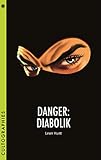Danger: Diabolik / Leon Hunt.
Material type: TextSeries: CultographiesPublisher: New York, NY : Columbia University Press, [2018]Copyright date: ©2018Description: 1 online resource : ‹B›B&W Photos: ‹/B›12Content type:
TextSeries: CultographiesPublisher: New York, NY : Columbia University Press, [2018]Copyright date: ©2018Description: 1 online resource : ‹B›B&W Photos: ‹/B›12Content type: - 9780231182812
- 9780231851121
- 791.43/72 23
- PN1997.D284 H86 2018eb
- online - DeGruyter
- Issued also in print.
| Item type | Current library | Call number | URL | Status | Notes | Barcode | |
|---|---|---|---|---|---|---|---|
 eBook
eBook
|
Biblioteca "Angelicum" Pont. Univ. S.Tommaso d'Aquino Nuvola online | online - DeGruyter (Browse shelf(Opens below)) | Online access | Not for loan (Accesso limitato) | Accesso per gli utenti autorizzati / Access for authorized users | (dgr)9780231851121 |
Frontmatter -- Contents -- Acknowledgements -- Introduction: Diabolik, chi sei? -- 1. From fumetto nero to 'wild and kooky cape-opera': Production, promotion, initial reception -- 2. 'Uh-oh - it's getting groovy!': The cult afterlife of Danger: Diabolik -- 3. Fantômas all'italiana: Analysis -- 4. Genius of Crime: The place of the film -- Notes -- Bibliography -- Index
restricted access online access with authorization star
http://purl.org/coar/access_right/c_16ec
Danger: Diabolik (1968) was adapted from a comic that has been a social phenomenon in Italy for over fifty years, featuring a masked master criminal-part Fantômas, part James Bond-and his elegant companion Eva Kant. The film partially reinvents the character as a countercultural prankster, subverting public officials and the national economy, and places him in a luxurious and futuristic underground hideout and Eva in a series of unforgettable outfits. A commercial disappointment on its original release, Danger: Diabolik's reputation has grown along with that of its director, Mario Bava, the quintessential cult auteur, while the pop-art glamour of its costumes and sets have caught the imagination of such people as Roman Coppola and the Beastie Boys.This study examines its status as a comic-book movie, including its relation both to the original fumetto and to its sister-film, Barbarella. It traces its production and initial reception in Italy, France, the U.S., and the UK, and its cult afterlife as both a pop-art classic and campy "bad film" featured in the final episode of Mystery Science Theatre 3000.
Issued also in print.
Mode of access: Internet via World Wide Web.
In English.
Description based on online resource; title from PDF title page (publisher's Web site, viewed 29. Mrz 2022)


